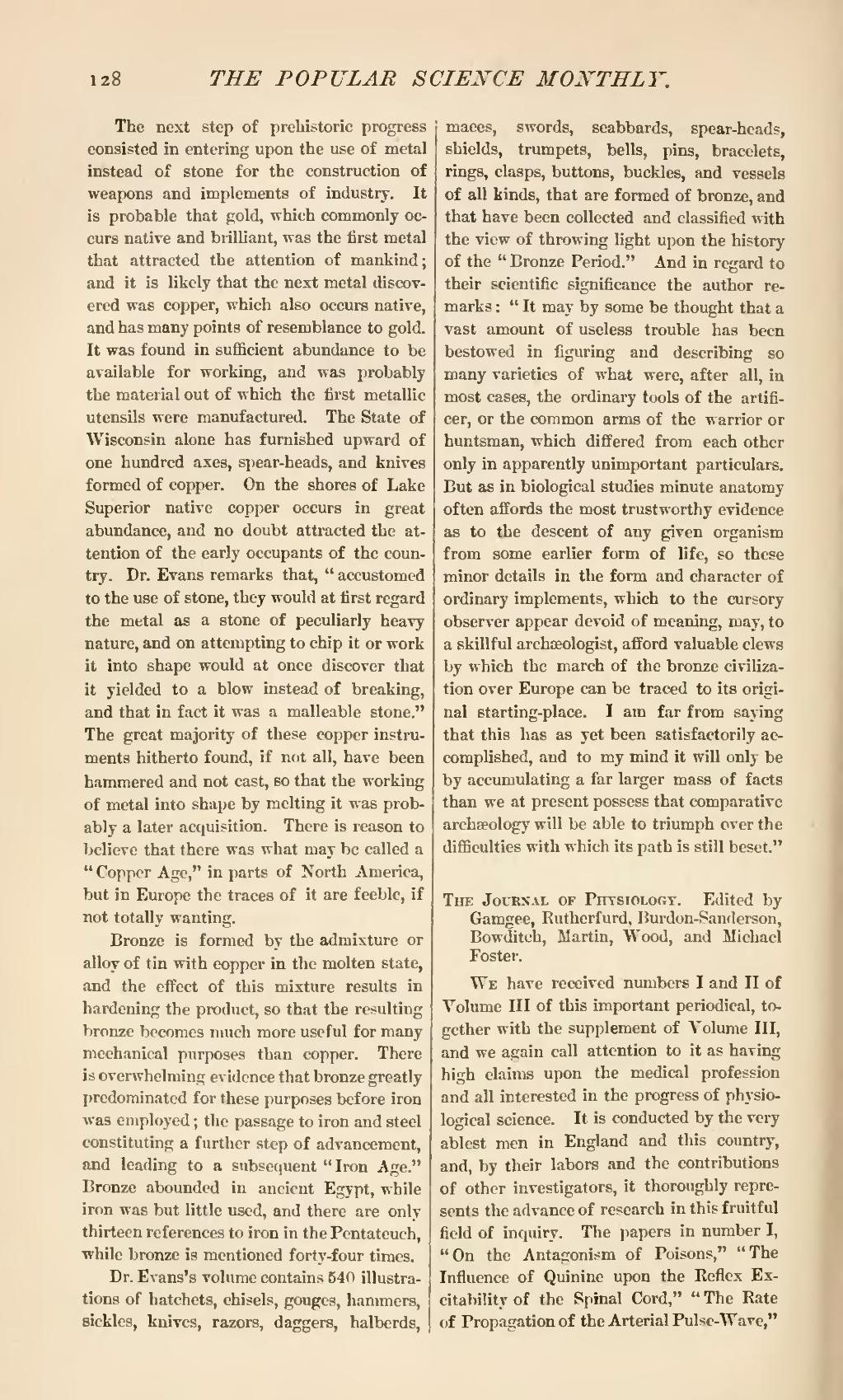The next step of prehistoric progress consisted in entering upon the use of metal instead of stone for the construction of weapons and implements of industry. It is probable that gold, which commonly occurs native and brilliant, was the first metal that attracted the attention of mankind; and it is likely that the next metal discovered was copper, which also occurs native, and has many points of resemblance to gold. It was found in sufficient abundance to be available for working, and was probably the material out of which the first metallic utensils were manufactured. The State of Wisconsin alone has furnished upward of one hundred axes, spear-heads, and knives formed of copper. On the shores of Lake Superior native copper occurs in great abundance, and no doubt attracted the attention of the early occupants of the country. Dr. Evans remarks that, "accustomed to the use of stone, they would at first regard the metal as a stone of peculiarly heavy nature, and on attempting to chip it or work it into shape would at once discover that it yielded to a blow instead of breaking, and that in fact it was a malleable stone." The great majority of these copper instruments hitherto found, if not all, have been hammered and not cast, so that the working of metal into shape by melting it was probably a later acquisition. There is reason to believe that there was what may be called a "Copper Age," in parts of North America, but in Europe the traces of it are feeble, if not totally wanting.
Bronze is formed by the admixture or alloy of tin with copper in the molten state, and the effect of this mixture results in hardening the product, so that the resulting bronze becomes much more useful for many mechanical purposes than copper. There is overwhelming evidence that bronze greatly predominated for these purposes before iron was employed; the passage to iron and steel constituting a further step of advancement, and leading to a subsequent "Iron Age." Bronze abounded in ancient Egypt, while iron was but little used, and there are only thirteen references to iron in the Pentateuch, while bronze is mentioned forty-four times.
Dr. Evans's volume contains 540 illustrations of hatchets, chisels, gouges, hammers, sickles, knives, razors, daggers, halberds, maces, swords, scabbards, spear-heads, shields, trumpets, bells, pins, bracelets, rings, clasps, buttons, buckles, and vessels of all kinds, that are formed of bronze, and that have been collected and classified with the view of throwing light upon the history of the "Bronze Period." And in regard to their scientific significance the author remarks: "It may by some be thought that a vast amount of useless trouble has been bestowed in figuring and describing so many varieties of what were, after all, in most cases, the ordinary tools of the artificer, or the common arms of the warrior or huntsman, which differed from each other only in apparently unimportant particulars. But as in biological studies minute anatomy often affords the most trustworthy evidence as to the descent of any given organism from some earlier form of life, so these minor details in the form and character of ordinary implements, which to the cursory observer appear devoid of meaning, may, to a skillful archæologist, afford valuable clews by which the march of the bronze civilization over Europe can be traced to its original starting-place. I am far from saying that this has as yet been satisfactorily accomplished, and to my mind it will only be by accumulating a far larger mass of facts than we at present possess that comparative archaeology will be able to triumph over the difficulties with which its path is still beset."
The Journal of Physiology. Edited by Gamgee, Rutherfurd, Burdon-Sanderson, Bowditch, Martin, Wood, and Michael Foster.
We have received numbers I and II of Volume III of this important periodical, together with the supplement of Volume III, and we again call attention to it as having high claims upon the medical profession and all interested in the progress of physiological science. It is conducted by the very ablest men in England and this country, and, by their labors and the contributions of other investigators, it thoroughly represents the advance of research in this fruitful field of inquiry. The papers in number I, "On the Antagonism of Poisons," "The Influence of Quinine upon the Reflex Excitability of the Spinal Cord," "The Rate of Propagation of the Arterial Pulse-Wave,"
